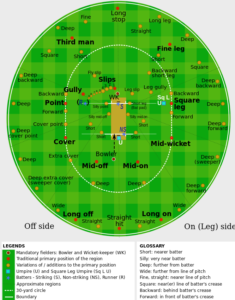Cricket Fielding Positions in Ground
Cricket fielding positions is crucial for both players and spectators alike. Players must be aware of their designated positions as decided by the captain, while spectators can amplify their enjoyment, especially when tuning in to Test Match Special on the radio. With only many fielding positions available at any given time, excluding the fixed positions of the bowler and wicket-keeper, mastering the art of strategic placement becomes a key aspect of the game. A well-organized fielding can turn the tide of a match in any situation.
Cricket Fielding Positions

Table of Main Cricket Fielding Positions
- Wicket Keeper
- First Slip
- Second slip
- Third Slip
- Fly Slip
- Third man
- Gully
- Silly Point
- Point
- Deep Point
- Cover
- Cover Point
- Extra Cover
- Deep Extra Cover
- Silly Mid Off
- Silly Mid On
- Mid Off
- Straight
- Mid On
- Long On
- Long Off
- Short Leg
- Short Mid-Wicket
- Mid-Wicket
- Deep Mid-Wicket
- Short Square Leg
- Square Leg
- Deep Square Leg
- Leg Gully
- Long Leg
- Leg Slip
- Short Fine Leg
- Deep Fine Leg
Fielding in Cricket
Cricket, a game of skill and strategy, involves intricate field placements that can make or break a match. One crucial aspect is the arrangement of fielders on the off-side and leg-side, a tactical dance between the bowler and batsman. Let’s unravel the complexities of this strategic chessboard.
1. The Basics: Off and Leg Side Defined
Understanding the basics is paramount. The off side and leg side refer to the two halves of the cricket field, divided by the line of the batsman’s stumps.
1.1 Off-Side Dominance
Most fielders usually find themselves on the off side. Why? Bowlers often target the off stump, leading to shots predominantly directed into this region.
2. Offensive Plays: Attacking with Precision
Strategies shift when a team goes on the offensive. Slip and gully positions dominate, creating a 7–2 field, enticing the batter to attack and make a potential misjudgment.
2.1 Leg Theory Unleashed
Leg spin bowlers may opt for a 4–5 field towards the leg side, aiming to force a stumping or induce a catch. Constraints exist, with a maximum of two fielders allowed behind square leg.
2.2 Off Theory Counter
Conversely, fast and slow bowlers may deploy an 7–8 off-side field, bowling wide outside off stump. It challenges the batsman to take risks to play short.
3.Defensive Maneuvers Adapting to the Situation
As teams adopt a more defensive stance, fielders redistribute, leading to 6–3 and 5–4 fields. The dance evolves, adapting to the ever-changing dynamics of the game.
3.1 Leg Side Trap
A specialized move involves placing fielders strategically on the leg side boundary, aiming for bouncers to induce the batter to hook the ball into the air. In this way the player gets a chance to catch out.
4. Leg and Off Theory Unveiled
Two distinct strategies emerge: Leg Theory and Off Theory, each altering the field dynamics significantly.
4.1 Leg Theory Unleashed
Spinners might stack the leg side with seven fielders, preventing easy scoring and pushing the batter to attempt unconventional shots.
4.2 Off Theory in Action
The reverse tactic involves seven or eight fielders on the off side, forcing the batter to attempt risky shots to break free.
At The End
Fielding keeps changing according to the situation of the match. A successful captain is one who sets the field according to the situation of the match. Because your win depends on your on ground fielding.
